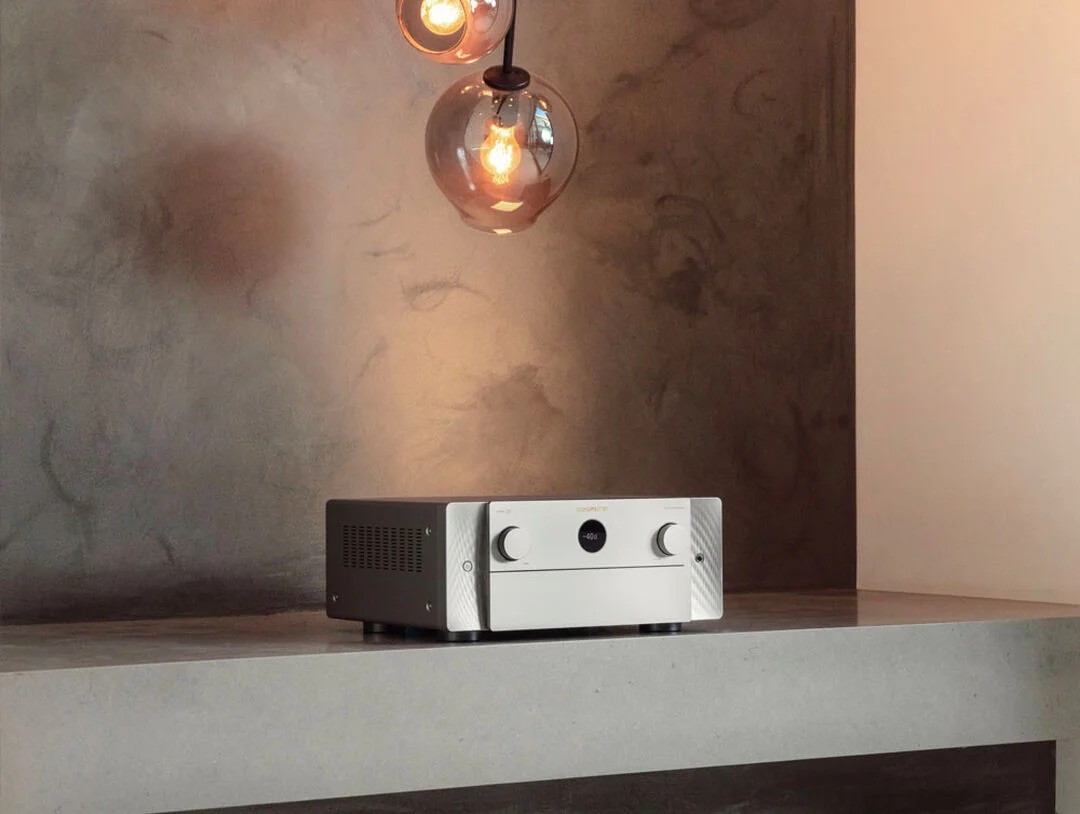Specs
| Maximum Dimensions: Antenna: Horizontal: (W x D x H) in inchesAntenna: Vertical: (W x D x H) in inchesw/o Antenna: (W x D x H) in inches | 17.4 x 18.0 x 7.5 17.4 x 18.0 x 10.2 17.4 x 17.6 x 7.5 |
| Weight in lbs. | 42.8 |
| Power Consumption in W | 780 |
| Number of Powered Channels | 11 |
| Power Output (8 ohm, 20 Hz – 20 kHz, 0.05% 2ch Drive) | 140W |
| Power Output (6 ohm, 1 kHz, 0.7% 2ch Drive) | 175W |
| Power Output (6 ohm, 1 kHz, 10% 1ch Drive) | 250W |
| Amplifier Topology | Class A/B |
| DTS | DTS HD Master, DTS:X, DTS:X Pro, DTS Neural:X, DTS Virtual:X |
| Dolby | Dolby TrueHD, Dolby Atmos, Dolby Atmos Height Virtualization, Dolby Atmos Music, Dolby Surround |
| Max Number of Processing (Preamp) Channels | 13.4 |
Review
This year, for Marantz’s flagship receiver, we got the Marantz Cinema 30. It has 8K and Dolby Atmos, 11.4 channels, with 140 watts per channel at 8 ohms and 175 watts per channel at 4 ohms using a Class A/B amplifier.
The Marantz Cinema 30 has four independent subwoofer outputs, it has seven separate HDMI 2.1 inputs that can accept inputs of 8K at 60 fps and 4K at 120 fps. This means it can handle the highest resolutions currently available and it will be good for the future too. It also has three HDMI monitor outputs and 1 supports HDMI eARC and ARC, this means that the Cinema 30 can support multiple displays simultaneously, even if they are in different rooms.
It supports Dolby Atmos, Dolby Vision, Spotify, Apple Airplay, Alexa, Tidal, and so much more. It can upscale signals like 1080p to 8K, using its HDMI connections. It also has features for gaming, like Variable Refresh Rates, Auto Low Latency Mode, and Quick Frame Transport. It has WiFi, Ethernet, and Bluetooth, and it supports streaming services natively or through its app.

The Marantz Cinema 30 can be configured for multi-room use, supporting up to 3 rooms, and it can also be used as a smart home ecosystem. You can configure this through the on-screen menu, which is amazing and has tons of features.
The setup is very easy for this device. When powered up for the first time, the Cinema 30 shows you a step-by-step process on how to configure it, it even shows you how to make connections. You can experiment with different speakers with the Cinema 30, each speaker offers a unique audio experience with this receiver.
For room correction, the Marantz Cinema 30 supports Audyssey MultEQ XT32 and Diraq. You will need to purchase a license to use Diraq, it will cost $799 for that license. The Audyssey software works well enough, but Diraq is the best option for those who don’t mind spending extra money on their home theatre, Diraq on the Cinema 30 is the most stable version yet. You can create three presets per speaker profile, and you can switch between them with just a click. As for Audyssey, it can match Diraq in performance if you buy a few extensions, but out of the bow I just prefer Diraq more.
For movies, the Marantz Cinema 30 is unmatched. The sound is fully detailed, it lets sharper sound effects hit you fully, but never allows them to cross the line. If you turn on Diraq with bass control, performance gets significantly better.
What’s in the box
- Marantz Cinema 30
- Remote Control
- Batteries
- AM/FM antennas
- Wire labels
- Quick start guide
- Audyssey microphone
- Cardboard microphone stand
- 2 External Detachable Antennas
- AC cord
Verdict
The Marantz Cinema 30 is a top-notch receiver that delivers powerful, future-proof performance with 8K, Dolby Atmos, and 11.4 channels. It is packed with features like HDMI 2.1 support, multi-room capability, and gaming enhancements. The setup is user-friendly, and while the Diraq room correction license is an extra cost, it offers superior performance. Overall, it’s an excellent choice for those looking to improve their home theatre.


1 thought on “Marantz Cinema 30 Review: Best Reciever Yet?”
Comments are closed.